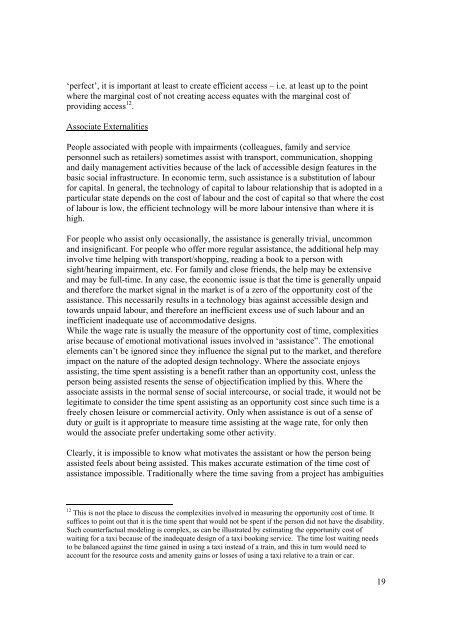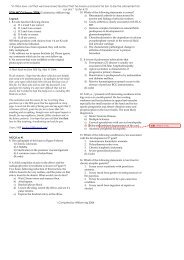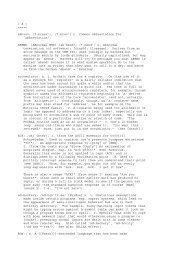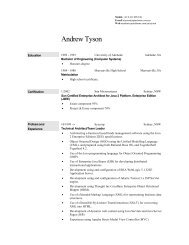Notes to Submission to the Productivity Commission Inquiry into the ...
Notes to Submission to the Productivity Commission Inquiry into the ...
Notes to Submission to the Productivity Commission Inquiry into the ...
Create successful ePaper yourself
Turn your PDF publications into a flip-book with our unique Google optimized e-Paper software.
‘perfect’, it is important at least <strong>to</strong> create efficient access – i.e. at least up <strong>to</strong> <strong>the</strong> pointwhere <strong>the</strong> marginal cost of not creating access equates with <strong>the</strong> marginal cost ofproviding access 12 .Associate ExternalitiesPeople associated with people with impairments (colleagues, family and servicepersonnel such as retailers) sometimes assist with transport, communication, shoppingand daily management activities because of <strong>the</strong> lack of accessible design features in <strong>the</strong>basic social infrastructure. In economic term, such assistance is a substitution of labourfor capital. In general, <strong>the</strong> technology of capital <strong>to</strong> labour relationship that is adopted in aparticular state depends on <strong>the</strong> cost of labour and <strong>the</strong> cost of capital so that where <strong>the</strong> cos<strong>to</strong>f labour is low, <strong>the</strong> efficient technology will be more labour intensive than where it ishigh.For people who assist only occasionally, <strong>the</strong> assistance is generally trivial, uncommonand insignificant. For people who offer more regular assistance, <strong>the</strong> additional help mayinvolve time helping with transport/shopping, reading a book <strong>to</strong> a person withsight/hearing impairment, etc. For family and close friends, <strong>the</strong> help may be extensiveand may be full-time. In any case, <strong>the</strong> economic issue is that <strong>the</strong> time is generally unpaidand <strong>the</strong>refore <strong>the</strong> market signal in <strong>the</strong> market is of a zero of <strong>the</strong> opportunity cost of <strong>the</strong>assistance. This necessarily results in a technology bias against accessible design and<strong>to</strong>wards unpaid labour, and <strong>the</strong>refore an inefficient excess use of such labour and aninefficient inadequate use of accommodative designs.While <strong>the</strong> wage rate is usually <strong>the</strong> measure of <strong>the</strong> opportunity cost of time, complexitiesarise because of emotional motivational issues involved in ‘assistance”. The emotionalelements can’t be ignored since <strong>the</strong>y influence <strong>the</strong> signal put <strong>to</strong> <strong>the</strong> market, and <strong>the</strong>reforeimpact on <strong>the</strong> nature of <strong>the</strong> adopted design technology. Where <strong>the</strong> associate enjoysassisting, <strong>the</strong> time spent assisting is a benefit ra<strong>the</strong>r than an opportunity cost, unless <strong>the</strong>person being assisted resents <strong>the</strong> sense of objectification implied by this. Where <strong>the</strong>associate assists in <strong>the</strong> normal sense of social intercourse, or social trade, it would not belegitimate <strong>to</strong> consider <strong>the</strong> time spent assisting as an opportunity cost since such time is afreely chosen leisure or commercial activity. Only when assistance is out of a sense ofduty or guilt is it appropriate <strong>to</strong> measure time assisting at <strong>the</strong> wage rate, for only <strong>the</strong>nwould <strong>the</strong> associate prefer undertaking some o<strong>the</strong>r activity.Clearly, it is impossible <strong>to</strong> know what motivates <strong>the</strong> assistant or how <strong>the</strong> person beingassisted feels about being assisted. This makes accurate estimation of <strong>the</strong> time cost ofassistance impossible. Traditionally where <strong>the</strong> time saving from a project has ambiguities12 This is not <strong>the</strong> place <strong>to</strong> discuss <strong>the</strong> complexities involved in measuring <strong>the</strong> opportunity cost of time. Itsuffices <strong>to</strong> point out that it is <strong>the</strong> time spent that would not be spent if <strong>the</strong> person did not have <strong>the</strong> disability.Such counterfactual modeling is complex, as can be illustrated by estimating <strong>the</strong> opportunity cost ofwaiting for a taxi because of <strong>the</strong> inadequate design of a taxi booking service. The time lost waiting needs<strong>to</strong> be balanced against <strong>the</strong> time gained in using a taxi instead of a train, and this in turn would need <strong>to</strong>account for <strong>the</strong> resource costs and amenity gains or losses of using a taxi relative <strong>to</strong> a train or car.19
















